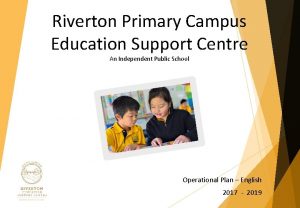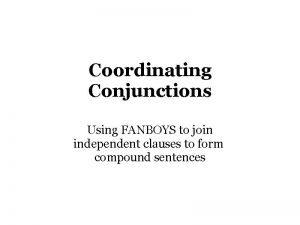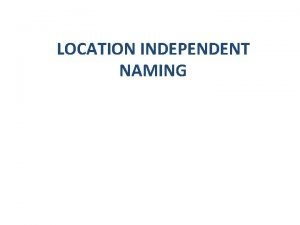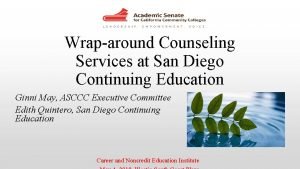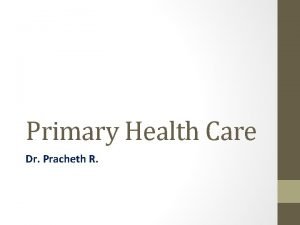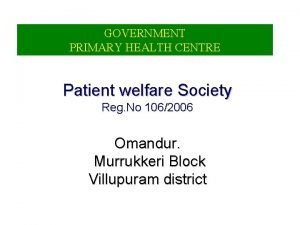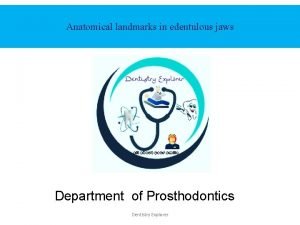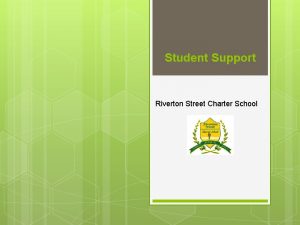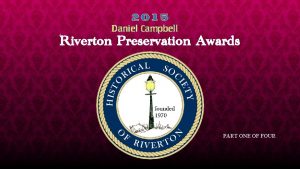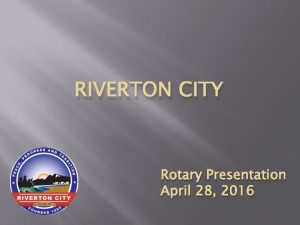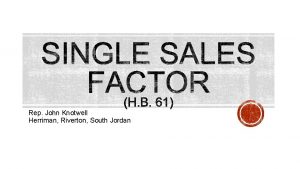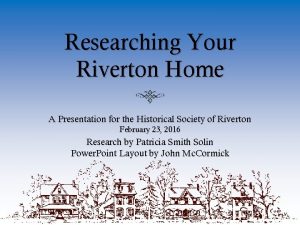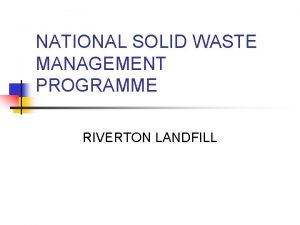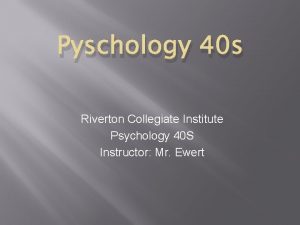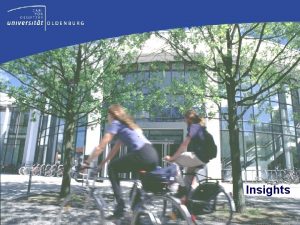Riverton Primary Campus Education Support Centre An Independent












- Slides: 12

Riverton Primary Campus Education Support Centre An Independent Public School Operational Plan – English 2017 - 2019

Riverton Education Support Centre Our School Vision Riverton Education Support Centre is part of the Riverton Primary Campus which is an inclusive community where students work collaboratively in a rich learning environment to achieve their academic, social and emotional potential. Purpose We aim to foster an environment that is inclusive for all at our School. We believe in providing opportunities for all students to access all areas of the curriculum. Strategic Directions Excellence in Teaching Excellence in Learning Positive Community Partnership Positive Healthy Community Riverton Education Support Centre

Rationale The study of English is central to the learning and development of all young Australians. It helps create confident communicators, imaginative thinkers and informed citizens. It is through the study of English that individuals learn to analyse, understand, communicate with and build relationships with others and with the world around them. At Riverton Education Support Centre students are provided with a comprehensive literacy program which is one of the priorities for our campus. Many students require Augmentative and alternative communication systems. These (AACs) encompass the communication methods used to supplement or replace speech or writing for those with impairments in the production or comprehension of spoken or written language. AAC is used by those with a wide range of speech and language impairments, including congenital impairments such as cerebral palsy, intellectual impairment and autism. Aim The Western Australian Curriculum: English aims to ensure that students: Learn to listen to, read, view, speak, write, create and reflect on increasingly complex and sophisticated spoken, written and multimodal texts across a growing range of contexts with accuracy, fluency and purpose Appreciate, enjoy and use the English language in all its variations and develop a sense of its richness and power to evoke feelings, convey information, form ideas, facilitate interaction with others, entertain, persuade and argue Understand how Standard Australian English works in its spoken and written forms and in combination with nonlinguistic forms of communication to create meaning Develop interest and skills in inquiring into the aesthetic aspects of texts, and develop an informed appreciation of literature. Students in the Riverton Education Support Centre will engage in activities at a level appropriate to their intellectual capacity, regardless of chronological age of the students. Each class to commit to 75 mins minimum English block per day. Preferably between 9. 00 am-10. 30 am daily Riverton Education Support Centre

Language/Literacy: Knowing about the English language Phase of Development Outcome Strategies Data/Monitoring Resources K-P Y 1 -2 Language variation and change Understand that English is one of many languages spoken in Australia and that different languages may be spoken by family, classmates and community. • Following verbal instructions- 1 step instructions e. g. collect equipment for the activity. (K) • Following 1 and 2 step instructions(K, P) • Non-verbal use of PECS, PODD, ALS board, Picture/symbol • Augmentative Communication Devices (refer to AAC Support Plan: appendix 1. ) • Employ therapists from the Language Development centre. • Social Skills Program, recess and lunchtime activities, request objects • Providing a classroom environment where students must initiate communication – Sabotage the environment • Stop, Look, Listen, student responds to name- turns toward speaker gives eye contact. • Greeting and farewells – sound communication • Chat books • Provision of activities within the classroom to facilitate communication – For example, Cooking • Input from families with English as another language (EAL) • • Chat books, News telling sessions • Different greetings for different contexts e. g. news vs. arriving in morning vs. greeting friends, adults • Model asking and answering questions • Barrier Games & Board Games • On entry assessment data • Individualised baseline data • Videos of students engaging in activities • Work samples in “Look What I Can Do” folders end of term 1 • Teacher checklists • Riverton Education Support Centre Semester 1 and 2 IEP/ Reports • Seesaw App to communicate information to parents • K-1 end of year wok sample portfolios Early Years Learning Framework WA Kindergarten Curriculum Guidelines Scootle $9000 AAC support from the Language development centre Teacher planning time: $550 per day x 10 Do. E online resources First Steps Language Development Words, Grammar and Fun Program Bright path moderation tasks when applicable SCSA Judging Standards Across Learning Areas Reading Eggs 3 -4 Riverton Education Support Centre • Following 1, 2 and 3 step instructions • Explicit teaching of conversational skills and opportunities to practise in social contexts • Public speaking opportunities. • Provide opportunities for dramatisation • INCAS “Interactive Computerised Assessment System” • Social Skills checklists for mainstream staff (for students integrating with mainstream students) • SEN reporting, level of assistance (SH, PH etc. ) • Communicate/work with student’s therapists to set goals and monitor outcomes

Phase of Development Outcome Strategies K-P Y 1 -2 3 -4 Language for Interaction Students learn that the language used by individuals varies according to their social setting and the relationships between the participants. They learn that accents and styles of speech and idiom are part of the creation and expression of personal and social identities • • Riverton Education Support Centre • • • • • First/then schedules: choice making. Using reinforcers to encourage speaking. Point to mouth/lips when talking Protective Behaviours Program Social Skills Program Sentence Strips Sabotage – making the environment difficult to access- so that Students have to verbalize their requirements Communication devices such as Nova chat ALS boards Modelled language with visual cues Model and emphasise eye contact Socialisation lessons. Explicit teaching: teach students to play and interact appropriately (K-4) Integration with mainstream students for Music, Physical Education, Science buddy class (Fridays), Art, recess and lunch breaks Think, Pair, Share Daily Diary Diana Rigg – Explicit Teaching of Sound (K-4) Word knowledge - vocabulary Sentence structure – grammar Language understanding – semantic and comprehension ability Structured thinking – elaborate, organise and sequence thoughts. Provide variety of opportunities to communicate within the community- Reporting to the Centre Manager’s office at different shopping centres, verbalizing greetings to Bus drivers, interacting with shop assistants Explicit teaching of conversational skills Public speaking opportunities. Provide opportunities for dramatization Provide explicit, systematic instruction in vocabulary. Teach individual sounds. Diana Rigg program using multi - sensory approach Ensure students have ample opportunities to talk with both adults and peers and provide ongoing feedback and encouragement. Data/Monitoring Resources Videos of students engaging in activities Work samples in “Look What I Can Do” folders end of term 1 Riverton Education Support Centre Semester 1 and 2 IEP/Reports Teacher checklists INCAS “Interactive Computerised Assessment System” K-1 end of year wok sample portfolios SEN reporting, level of assistance (SH, PH etc. ) Seesaw App to communicate information to parents Diana Rigg monitoring systems Rubric on standard skills/achievement Boardmaker resources: First/ Then schedules, sentence strips, ALS boards. Protective Behaviours programs for each year level. Communication Devices. Social Skills Program resources/playground and in-class resources WA Curriculum resources Reading Eggs Phases of development SCSA On Line Resources First Steps Speaking and Listening documents Bug Club Application downloading costs: $10 per i. Pad X 25 Diana Rigg Phonological Awareness Program Resource person to develop appropriate resources: 1 day per week. $20 000

Phase of Development Outcome Strategies Data/Monitoring K-P Y 1 -2 3 -4 Text Structure and Organization Students learn how texts are structured to achieve particular purposes; how language is used to create texts that are cohesive and coherent; how texts about more specialized topics contain more complex language patterns and features; and how the author guides the reader/viewer through the text through effective use of resources at the level of the whole text, the paragraph and the sentence Design instruction that focuses on all of the foundational literacy skills. • interactive storybook reading • "pretend" reading and writing • games and other activities to help children identify the letters of the alphabet • interactive experiences with language and print through poems, nursery rhymes and songs • role play based on texts students are reading Phonological awareness refers to the ability to manipulate the sounds that make up language, independent of meaning. learning to recognize rhyming words listening for syllables within words learning to recognize beginning sounds in words matching those sounds to letters Print awareness is an understanding of the features of books and print. Children will: be taught to recognize the parts of a book (e. g. , front and back covers, top and bottom) (P) learn that printed letters and words run from left to right and from top to bottom( Y 1, 2) learn that a book has a title, was written by an author, and has illustrations that were drawn by an illustrator have regular exposure to modelled writing – procedures; recipes “how to” activities (steps) - narratives/retells (middle, Beginning and end) be explicitly taught editing skills produce recounts: written and oral with/without adult scribing/scaffolding be explicitly taught grammar • Riverton Education Support Centre • • • Videos of students engaging in activities Work samples in “Look What I Can Do” folders end of term 1 Riverton Education Support Centre Semester 1 and 2 IEP/Reports Seesaw App to communicate information to parents Rubric on standard skills/achievement K-1 end of year wok sample portfolios • INCAS “Interactive Computerised Assessment System” • The Australian Standardised Spelling test • Fountas and Pinnell Benchmark Assessment System • Early Literacy Screening Tools - PLD organisation Resources Teaching and Learning about Words by Maryanne Wolf First Steps Reading Resource Books AAC Language Lab First Steps Writing Resource Books Word charts Environmental print Diana Rigg Program Reading Eggs Onset and Rime Kits ECU Phonics Scope and Sequence

Phase of Development Outcome Strategies Y 1 -4 Expressing and developing ideas Students learn how, in a text, effective authors control and use an increasingly differentiated range of clause structures, words and word groups, as well as combinations of sound, image, movement, verbal elements and layout. • • • K-P 1 -2 3 -4 Sound & Letter Knowledge Students develop knowledge about the sounds of English and learn to identify the sounds in spoken words. They learn the letters of the alphabet and how to represent spoken words by using combinations of these letters. • Name recognition • Picture/symbol matching • multi-sensory activities in spelling (shaving cream, chalk, paint) • Interactive games, activities and songs • Explicit teaching of the letters of the alphabet and correlating sounds. • Explicit teaching of the correlation between isolated sounds and sounds in words. • Frequent opportunities for students to identify sounds orally and in print. • Explicit teaching of beginning writing skills to allow students to experiment with writing sight words and known words. • Explicit teaching of phonemic awareness skills such as onset and rime to facilitate the experimentation with spelling of words. • Games to develop letter/sound knowledge (fish, concentration etc. ) • Phonological Awareness activities: What do I have? A /c/-/a/-/t/ etc. Riverton Education Support Centre News writing – based on personal experience Language based activities based on news Sentence reconstruction Data/Monitoring • • • Resources Videos of students engaging in activities Work samples in “Look What I Can Do” folders end of term 1 Riverton Education Support Centre Semester 1 and 2 IEP/Report K-1 end of year wok sample portfolios Diana Rigg Phonological Awareness Program Writing templates Bug Club INCAS “Interactive Computerised Assessment System” Seesaw Videos/Photographs of students engaging in activities Work samples in “Look What I Can Do” folders end of term 1 Riverton Education Support Centre Semester 1 and 2 IEP/Report K-1 end of year wok sample portfolios First Steps Reading Resource Books Bug Club Starfall Busy Things Reading Eggs

Literature: Understanding, appreciating, responding to, analysing and creating literature Phase of Development Outcome Strategies Data/Monitoring K-P Y 1 -2 Students learn how ideas and viewpoints about events, issues and characters that are expressed by authors in texts are drawn from and shaped by different historical, social and cultural contexts. Responding to literature Students learn to identify personal ideas, experiences and opinions about literacy texts and discuss them with others. They learn how to recognize areas of agreement and difference, and how to develop and refine their interpretations through discussion and argument Examining Literature Students learn how to explain and analyze the ways in which stories, characters, settings and experiences are reflected in particular literacy genres, and how to discuss the appeal of these genres. They learn how to compare and appraise the ways authors use language and literacy techniques and devices to influence readers. • Riverton Education Support Centre Shared reading Modelled reading Focused comprehension tasks based on Bug Club literature • • Awareness of non-verbal techniques through explicit teaching and modelling. Explicit teaching of listening and speaking behaviours. Explicit teaching of conversational skills Use of technology to support learning: photo story, video, Power Point etc. Public speaking opportunities. Immersion of nursery rhymes, traditional tales. Oral reading of text – discussion about similarities between own life and text Explicit teaching of oral sentence structure Explicit teaching of chants, rhymes, poetry, songs, nursery rhymes Explicit teaching of structure of conversations, discussions and oral presentations Awareness of Non-verbal techniques through explicit teaching and modelling- inferred meaning Exposure to a range of text at library – modelled reading • • Videos of students engaging in activities Work samples in “Look What I Can Do” folders end of term 1 Riverton Education Support Centre Semester 1 and 2 IEP/ Report Seesaw Teacher checklists K-1 end of year wok sample portfolios SEN reporting, level of assistance (SH, PH etc Resources First Steps Writing Resource Books Bug Club First Steps Speaking and Listening documents Do. E online resources

Phase of Development Outcome Strategies Data/Monitoring 3 -4 They also learn to understand, interpret, discuss and evaluate how certain stylists’ choices can create multiple layers of interpretations and effect. Creating Literature Students learn how to use personal knowledge and literary texts as starting points to create imaginative writing in different forms and genres and for particular audiences. Using print, digital and online media, students develop skills that allow them to convey meaning, address significant issues and heighten engagement and impact. Writing prompts/story starters Scaffolded story writing Story cubes – roll cubes to get who, where and problem Provide problem situations for students to expand upon Frequent opportunities for students to edit own work for spelling, meaning, full stops and capital letters Writing for a purpose: setting tasks which produce materials for use in other contexts e. g. : buddy class, library etc. Utilize Diana Rigg strategies for the teaching of Writing Explicit teaching of a range of different text structures with a focus on Recount, Narrative • Texts in Context Students learn that texts from different cultures or historical periods may reveal different patterns in how they go about narrating, informing and persuading. • • Guided reading in small groups Shared and modelled reading of a variety of text types, narrative, persuasive text, explanation and information report Nightly home reading Students engage in Book Week activities Provide opportunities for reading in different contexts and for different purposes e. g. newspaper reading, TV programs, timetables, magazines, catalogues • 1 -4 Riverton Education Support Centre • • • Resources Videos of students engaging in activities Work samples in “Look What I Can Do” folders end of term 1 Riverton Education Support Centre Semester 1 and 2 IEP/ Report Seesaw Social Skills checklist for students integrating in mainstream First Steps Writing Resource Books Do. E online resources Diana Rigg Writing Program Videos of students engaging in activities Work samples in “Look What I Can Do” folders end of term 1 Riverton Education Support Centre Semester 1 and 2 IEP/ Report Bug Club resources Magazines Newspapers Catalogues Reading Eggs First Steps Reading resources

Phase of Development Outcome Strategies Interacting with others Students learn how individuals and groups use language patterns to express ideas and key concepts to develop and defend arguments. They learn how to promote a point of view by designing, rehearsing and delivering spoken and written presentations and by appropriately selecting and sequencing linguistic and multimodal elements. Interpreting, analyzing and evaluating Students learn to comprehend what they read and view by applying growing contextual, semantic, grammatical and phonic knowledge. They develop more sophisticated processes for interpreting, analyzing, evaluating and critiquing ideas, information and issues from variety or sources. They explore the ways conventions and structures are used in written, digital, multimedia and cinematic texts to entertain, inform and persuade audiences, and they use their growing knowledge of textual features to explain how texts make an impact on different audiences. • • Riverton Education Support Centre • • • • Active listening book (social stories) Role playing Explicit teaching of vocabulary Explicit teaching of oral sentence structure and news telling. Explicit teaching of structure of conversations, discussions and oral presentations Explicit teaching of conversational skills Public speaking opportunities. Provide opportunities for dramatization Provide visual supports to allow students to sustain conversations Comprehension activities based on personal experiences and familiar text. Teachers will explicitly teach students the three levels of questioning specifically; Literal Level Inferential Level Evaluative Level Classes engage in Book Week activities Utilize First Steps strategies for the teaching of Reading. Provide opportunities for script writing. Provide opportunities for reading in different contexts and for different purposes e. g. newspaper reading, TV programs, timetables, magazines, catalogues, Explicit teaching of poetry specifically limericks, free verse, rhymes, shape poem, colour poem, diamante, acrostic Data/Monitoring • • • Seesaw INCAS “Interactive Computerised Assessment System” Teacher checklists SEN reporting, level of assistance (SH, PH etc. ) K-1 end of year wok sample portfolios Resources First Steps Speaking and Listening resources Do. E online resources Scootle

Phase of Development Outcome Strategies Data/Monitoring Creating texts: Students apply knowledge they gave developed in other strands and sub-strands to create with clarity, authority and novelty a range of spoken, written and multimodal texts that entertain, inform and persuade audiences. They do so by strategically selecting key aspects of a topic as well as language, visual and audio features. They learn how to edit for enhanced meaning and effect by refining ideas, reordering sentences, adding or substituting words for clarity, and removing repetition. They develop and consolidate a handwriting style that is legible, fluent and automatic, and that supports sustained writing. They learn to use a range of software programs including word processing software, selecting purposefully from a range of functions to communicate and create clear, effective, informative and innovative texts. News writing Educreations – creating own story or procedure Puppet Pals on i. Pads – creating oral storylines Daily opportunities to participate in Writing for a purpose: setting tasks which produce materials for use in other contexts. Explicit teaching of Narrative, Explanation, Information Report, Persuasive Text using appropriate writing framework. Explicit teaching of adjectives, and creative writing processes. Exposure to all written text forms and structures. Whole school approach to NSW Handwriting to be rolled out as at 2017? Editing process and editing key implemented. Frequent opportunities for students to edit own work with an emphasis on grammar and punctuation. Explicit teaching of paragraphing, problem and solution development. Publish writing in word processing programs e. g. Microsoft Word (multi-model literacy development) Create Power Points that include multi-literacies e. g. images, text, videos • Riverton Education Support Centre • • • Videos of students engaging in activities Work samples in “Look What I Can Do” folders end of term 1 Riverton Education Support Centre Semester 1 and 2 IEP/Report Seesaw Moderation Tasks-Narrative Resources First Steps Writing Resources Do. E online resources Diana Rigg Writing Program

Riverton Education Support Centre 255 Corinthian Road East, Riverton Western Australia 6148 9457 8307 riverton. ps@education. wa. edu. au www. rivertonprimary. wa. edu. au
 Riverton education support centre
Riverton education support centre Centroid engineering
Centroid engineering Centre of gravity of different shapes
Centre of gravity of different shapes Two main clauses
Two main clauses Edip army
Edip army Defence centre of training support
Defence centre of training support Location independent network
Location independent network San diego continuing education north city campus
San diego continuing education north city campus Major details vs minor details
Major details vs minor details Phc staff pattern
Phc staff pattern Villupuram district primary health centre
Villupuram district primary health centre Primary and support activities
Primary and support activities Relief areas of maxilla
Relief areas of maxilla
